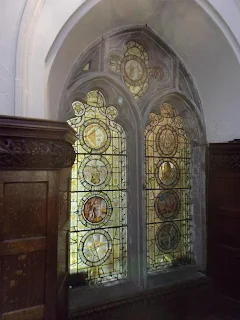The hallowed ground of Butlin's Filey represents something of a fasciation for me. The largest of the Butlin's holiday camps, it was also the favourite site of their founder- entrepreneur Billy Butlin (1899-1980).
Here is the first photograph I took after arriving at Primrose Valley, taking in Filey Bay- it looks quite atmospheric as the mist was rolling in from the sea. The lump in the centre of the photo is the White House- the Art Deco home Billy Butlin bought in 1945.
Sir Billy Butlin originally owned nine holiday camps:
Ayr- Opened in 1947, operating as a Haven site called Craig Tara since 1999.
Barry Island- Opened in 1966, closed in 1986 but operated independently until 1996, before being demolished in 2005.
Bognor Regis- Opened in 1960 and still a Butlin's.
Clacton- Opened in 1936, closed in 1983 and has now been redeveloped into a housing estate.
Filey- Opened in 1945 and closed in 1983, although there was an attempt by an independent company to operate it in 1986. Nowadays the north section is now Haven Primrose Valley, and the south section The Bay; another holiday park.
Minehead- Opened in1962 and still a Butlin's.
Mosney- Opened in 1948, closed in 1980 and has operated as a refugee centre for asylum seekers since 2000.
Pwllheli- Opened in 1947, operating as a Haven site called Hafan Y Mor since 1999.
Skegness- Opened in 1936 and still a Butlin's.
There were also Butlin's hotels in Blackpool, Cliftonville, Llandudno, London, Saltdean and Scarborough, plus overseas hotels in the Bahamas and Spain. Some of these are still working hotels; albeit no longer under Butlin's ownership.
As a child I visited seven of the nine holiday camps- some before I can even remember, some more than once. I've been a member of the Butlin's Memories website (and later its Facebook page) for a long time for this reason.
Looking north towards Filey town and Filey Brigg.
My memories are nebulous and fleeting- I was last here 44 years ago and was only eight- but I believe my parents and I walked into Filey and took a look around the town then spent some time on the beach. A non-swimmer at the time, I went to play in the little pools near the shore and became engrossed; soon paddling from pool to pool and venturing too far up the beach. My dad had to come and find me and I got a good telling off!
I think the reason Filey holds such an enchantment for Butlin's aficionados is that Haven Primrose Valley (which, during Butlin's Filey days, operated a small caravan park adjacent to Butlin's) took some time to buy up all of the Butlin's land, meaning that remnants of the camp stood for quite some years, making it the ideal site for a bit of nostalgic nosey-parkering to take place.Our caravan was on part of the site which was always Primrose Valley, and here is a cute landscaped lake nearby.
There is very little of "old Butlin's" left, but I was determined to find what was; like these stairs, which are probably the only intact relic from that time. They once led up to beautiful rock gardens.
A closer view and nowadays a car park sits at the top of them.
The view down, and you can see where additional steps have been added, to form a slight curve at the top.
2024 update
I missed this last time!
The low wall to the right as you enter Primrose Valley is from Butlin's days. It leads around to the original steps.
You can get some idea of the thickness of the wall here, as you come round from the old north gate entrance...
I've seen photos of kids perching on this wall during Butlin's days...
The wall continues on both sides of the old steps...
Just to put the wall into perspective, here you can see it at the back of the grass verge (not so easy to see on my previous steps photo, which was taken in May last year, when the surrounding hedges were more verdant.)
Here is an aerial photograph of Primrose Valley overlaid with Butlin's Filey.
It's actually an old map- the deep centre of the old Butlin's outdoor pool is visible and the majority of the area is now a sea of caravans, with The Bay development now present to the right.
Apparently an updated version sits on the wall of the Owners' Lounge.
Map from Facebook: Owners at Haven Primrose Valley
This map is from 1982- only three years after I was last there- and gives you some idea of the mass of entertainment buildings (and therefore the variety of entertainment available) back in the day. Primrose Valley has two entertainment buildings, and the SuperDean complained, 'There's not enough for adults to do during the day here.'
You wouldn't have heard that during Billy Butlin's time!
Map from the Butlin's Memories website (map courtesy of Keith Franklin.)
Butlin's once had its own railway station. The trains ran from 1947-1977, when both dropping visitor numbers and train users resulted in its closure. There was once a tunnel used to transport visitors underneath the road from the station, using the Puffing Billy land trains.
This is where the tunnels (there were three; two for the land train, one going in each direction, and one for foot passengers) emerged on the Butlin's side. They were accessed for survey reasons earlier this year and were found to be flooded.
The station was across the A165, and also accessible via the gate to the right of this turn-off.
Steps up to the gate overlooking the station. I believe this is the original gate.
Over the gate and there's really not much to see. The farmer (probably sick of historians trespassing onto his land) filled the tunnel entrances at his end with rubble, also covering the stairs which led down to the station with large rocks before finally destroying the platforms in 2022.
2024 update
As you can see, in the 18 months since I was last here the farmer has totally removed the original gate, and thrown a load of branches in front of the top of the steps.
This comfortable little arrangement sits behind caravans in Hawthorne Way; on which once stood the York Dining Halls (my old dining hall) and, nearby, the camp end chairlift station. As a precocious eight-year-old I insisted on walking to the dining hall by myself one breakfast time. As I preferred coffee (which you had to ask for, and I suppose I was as introverted then as I am now) to tea (which came automatically) I pinched a pot off another table. A waitress called Julie caught me doing so and told me off!
Fortunately my waitress automatically brought our table coffee that day, so I got my morning beverage of choice.😃
These are thought to be original walls. There are rumours that the original steps up to the chairlift station slope away up the bank behind this little wall. It does indeed slope- not just sideways to the left towards Magnolia Court but also directly forwards at an angle.
A closer view of the bank (taken with me standing beside the wall looking behind the caravan) and it's quite possible that there are stairs here. However, I don't go on holiday armed with my steel-toe-cap boots, gardening gloves, weed killer and secateurs, so I wasn't about to find out!
There once stood a fountain on roughly the same spot as this one- only the (north) fountain was part of the old outdoor swimming pool, with another (south) fountain at the other end. Apparently, when there is a bit of a drought and the water level drops, it is possible to make out the original blue swimming pool wallsWhere the caravans are would be where the Heated Indoor Swimming Pool sat.
This was the first time I had ever been in a swimming pool, as opposed to a paddling pool, or paddling in the sea- my parents didn't swim, so I didn't get the chance. I remember playing in the north fountain then slipping into the nearby children's end of the pool (I think both ends were for kids; with serious swimmers accommodated in the middle, with diving boards.) I loved being in the water, and liked that the water came up nearly to my chest- deep enough for me to practise my swimming.
Standing overlooking the lake, from the spot where the indoor pool had been, roughly from the children's end.
It was the first time I had ever been in an indoor pool, too. My recollections are indefinite- I think I only went in once but I remember clinging to the side of the pool whilst chatting to some other girls and staring up at the brilliant sunshine streaming through the long windows. In future Butlin's camps I visited they kind of had a metal barrier close to the pool's edge. This camp didn't, and images I've seen of it and my memories fit together so it's true- I was here!
I love this photo and think it's nice what they've tried to do with the area ("nice" is a word I seem to use a lot when describing Primrose Valley- rather a bland choice of word, don't you think?)
But I preferred it the way it was...
Underneath this section of the lake there is apparently some original boating lake edging, but I couldn't really get close enough to gape without falling in!
The Santa Fe Railway crossed over the lake, between islands which actually stood in the lake. These are the original trees which were on the islands.
The area is now the Owners' Golf Course. I had to be careful when I was taking pictures as there was someone on the fairway!
The roller skating rink would have sat to the right, with the fairground just in front of the caravans in the distance.
My Green Camp chalet would have been behind that, although I can't remember which row or number it was. I'm guessing that if it still existed then it would actually be floating in one of the landscaped lakes (there are several on the site.)
I remember going down the bumpy, bumpy fairground slide several times. The friction caught my heels (I always drove my dad mad by insisting on the highest heeled shoes I could get away with!) and damaged my new shoes, bought to be worn back at school the following week.
This tree now sits at the border of Primrose Valley and The Bay. It once stood on a small roundabout on the road which led from the main gates over to reception.
After hunting down roughly where I thought my old chalet had been, I doubled back and made my way up the main thoroughfare north, and this final section of roadway is original. Looking back south and the Neolithic obelisks on either side of the road are Primrose Valley additions. The Gaiety Building would have been behind the hedge on the left.
The east obelisk, and it was so quiet around the camp. I can't remember any Butlin's camps ever being that deserted, but then again I was walking through caravan city.
The camp end chairlift station would have been to the right, over the hedge in front of this west obelisk.
Whilst there is no doubt that I would have ridden the chairlift, I don't recall it specifically. It was the only other time I've ever been to Filey and so long ago that it's easy for my memories to become discombobulated.
Looking north and the chairlifts would have crossed this road from the station to the left, upwards over this original tree before heading towards the beach end chairlift station. The Gaiety Building was behind where I stood to take this photo.
We always went to the Gaiety Theatre to watch the nightly show after our evening meal. Sometimes I referred to these shows as "borination!" It's interesting as nowadays it's exactly the kind of thing I like. But I suppose it's not that easy for a child to sit still for a full hour and concentrate.
Walking further down and here are the original edgings to the tennis courts.
I didn't play then and don't play now, disliking sport immensely and being totally useless at it, so much so that I once got slung out of P.E. at school! Ironically that ejection from the class would have occurred during the year following this holiday.
Around the corner there are more of these tennis court walls left but they're hidden behind hedges.

I zig-zagged back on myself again, marching further east, and after a very long walk through masses of caravans I found the beach road. The turning circle on the way down serves both Primrose Valley and The Bay nowadays. The Puffing Billy train would have transported the campers to and from this point.
To the left of the turning circle a path leads off, and it's down here that the beach end chairlift station would have stood. Its base would have been somewhere underneath this wild meadow.
Looking at the turning circle, from the rough path. The chairlift station would have been just behind me to the left.
As I headed down the (quite long and steep in places) road towards the sea I was aware of mist rolling in- it gives this photo quite a spooky edge! I got down to the beach and soon turned back- visibility was restricted to only a few metres in front of my face.
I headed over to The Bay, and this pub is the John Paul Jones- not to be confused with John Paul Young, who sang Love Is In The Air...😄

It's the pub serving The Bay residents, and John Paul Jones (1747-1792) was a Scottish-American naval commander, associated with The Battle of Flamborough Head (1779).
On the outer wall of the pub (hidden by an open door) sits a plaque dedicated to Sir Billy Butlin and Butlin's Filey; the largest holiday camp in the world. It's the only recognition of what this great site once was, which I found quite sad.
Although outside the pub looked quite lively, the rest of The Bay was decidedly quiet. The original reception building would have ran lengthways where the holiday homes on the left hand side of the road are.
I vaguely remember checking in and out, collecting our keys and handing them back to reception- I believe you had to pay a deposit in those days. We checked in hours later than we should have as our coach had been seriously delayed. We'd missed our evening meal and, after finding our chalet and dumping our suitcases, my rather irate father took us to the camp restaurant. Fish and chips rings a bell...
I hunted for the area where the stables and elephant house once sat.Between 1957-1961 the latter housed Big Charlie; a 5.5 ton Asian elephant who was the largest elephant in captivity at the time. After his devoted mahout Ibrahim fell ill quite suddenly and passed away Charlie couldn't settle and became difficult to control (elephants and mahouts mate for life). It was decided, with advice from the RSPCA, that Charlie was to be gassed whilst he was in his house and at his most relaxed.
Ibrahim and Charlie.
Photo:- www.prom-prom.com
A pit was dug at the front of the elephant house and he was dragged outside by a tractor and buried right there. He's roughly where the taller, darker flowers/weeds are growing to the left of the photo at the top of the grass.
Standing in the scrub and you can see the path to the left, and the darker flowers just to the right of that. He was easy to find following some research.
Big Charlie's Grave is now referenced on Google Maps.🐘
2025 update
I was slightly out with locating Charlie's grave, so here he is according to Google Maps with me checking as I was hunting. You can see the bushes/ curve of the grass pathway for reference (I'm facing away from The Bay; the opposite way to where I first thought he was.) Charlie is roughly under the clump of long grass more or less in the centre of the photo. You can see where I've trampled the grass looking to stand on the exact spot (bearing in mind that the exact spot would be elephant-sized and rather large!)
Screenshot proof!
I then left The Bay, exiting onto the main road.
The layby to the left is where our delayed coach would have arrived. We'd been stuck at Newark for the best part of three hours waiting for a replacement coach as the first one caught fire underneath.
I remember us crossing the road in the dark.
The old south gate into Butlin's Filey, where we would have entered the camp. The north gate- which is now the Primrose Valley main gate- was only for staff and deliveries back then. The gate now overlooks the Owners' Golf Course.

I remember that Butlin's was brilliantly lit, with welcoming flags flying overhead.
😃😃😃
💓
During Butlin's days this house opposite the camp was the entertainment manager's accommodation. The funny faces on the wall apparently came from Butlin's Filey, although the dolphins came from Scarborough Zoo and Marineland.
A second episode of nosey-parkering and reminiscing had to take place, and this time the beach was my destination, but first I took this photograph from the top of the cliffs.
The White House was built in the 1930s and Billy Butlin purchased it in 1945, as he wanted to be near his beloved Filey camp. This stunning Art Deco property had 16 bedrooms, 10 bathrooms and six reception rooms.
I walked down to the beach via the turning circle. There is another available path down, but it involves trekking through woodland and exits further up, nearer to Filey town.
This World War II pill box, built as defence against possible enemy invasion, sits near the beach exit, at a bit of an angle. Anti-tank blocks were placed in a line along the foot of dunes, with pill boxes placed behind.
I ventured in...
I had to duck, but I had a small shuffle along...
Both pill boxes date from 1940/41. This one is even more wonky; the result of coastal erosion, and here you can see my shoes resting on the anti-tank blocks!
I had a paddle and looked back at the beach entrance, engrossed in my memories. The sea here is deceptive, in that it breaks quite far out then seems to slide in much further than you think it would.
I took three of my dolls with me on this particular holiday. Dressy Bessie was my favourite, and although my parents didn't swim my dad always took me for a paddle. I put my Bessie down and went a-paddling, but a wave came in further than either of us thought it would, and all too soon my dolly was having a swimming lesson!
The water seemed okay- until you stood in it for too long, then it became icy!
I wrote a poem about my Bessie- it only took five minutes to write but I entered it into a competition and was a runner up. I also published it as part of an anthology.
Here is a PDF of my Bessie...
Here is the Amazon link to my anthology, with my heartfelt poem below:-
DRESSY BESSIE
Dressy Bessy (I spelt her Bessie)
When I wrote about her
(which I did as well as draw)
Designed to help
(she had zips, ties and a buckle)
Was my favourite doll
(I loved her)
My doll of dubious provenance
was not an it, she was a her...
(I loved her)
She had beautiful ginger hair
With a kiss curl at the front
her head was made of felt
Her brains fell out!
(as she was cuddled so much)
My mum bought felt
(stitched her a new head)
On Filey beach, having a paddle with my dad
A wave came in, higher than expected
She went swim swim!
My dad (my hero) caught her
She dried off in a Butlin's chalet
I gave her a picture family
A mum named Bettina
Girls with kiss curls
Twin boys, curly hair
Bettina was pregnant
'A sausage machine,' my mum said
'You can't have kids so close together!'
Under the stairs, in my parents' house
Nearly 40 years ago
(I still love you, I still miss you)
It's been sold
(so I was told)
If that's the case, she ended up on a skip
Oh! That can of worms!
I'm crying for everything now
(I love you all)
Back to the present day and I then took a wander towards Billy Butlin's house. Billy Butlin moved to Jersey in 1969.
The house was used as holiday lets, and was converted into two apartments and four beach chalets, accessible by a beach road available for residents only.
Filey White House has now closed its doors to paying visitors.
The view over to Flamborough Head, stepping on a watery beach as smooth as glass.
2024 update
I wandered further down the beach towards Filey, and here are the steps leading up to Billy Butlin's old house...
There are a myriad of odd things along this section of beach.
What on earth is this long lump of concrete? I've read that it was a slipway for flying machines from Filey Flying School. The location would be correct- Flat Cliffs near Primrose Valley.
But further research revealed that there was once a slipway, constructed 1909/10, but on photos it looks flatter and larger, and the beach end was destroyed at the beginning of WWII so that the enemy couldn't gain possible access via that route. Also, this concrete is too modern to be anything to do with the flying school.
These destroyed concrete steps were once part of steps which zig-zagged up the cliff, towards Primrose Valley. I've read that they were never anything to do with Butlin's, and were built quickly at the start of WWII so that the Home Guard could patrol the beach. But this is disputed, and others have said that those steps were further up, near Flat Cliffs, and these were constructed in the 1960s. Very badly, by the sound of it- they must have been thrown up, and had deteriorated badly and begun to slip within a decade.
They are more-or-less level with the Primrose Valley reception. The upright sections were walls which stood either side of the steps, linked to the small anti-tank defensive walls which once ran along this beach.
I spotted a few metal strips poking up- could they have been underpinning for the steps, or held railings in place? But apparently they were part of the anti-tank defence walls.
There are also old railings strewn at the base of the cliffs nearby.
But what is this well-like thing? There are two of them, and I didn't care to dip a foot in to see how deep they were!
Research revealed that they were bins created from short lengths of drainage pipe.
A third episode of nostalgia had to be fitted in, so I stood on the bank facing what were the pools. Imagine if you can: a long outdoor pool running right from that fountain towards another fountain. Behind that a building with Heated Indoor Swimming Pool written on it in huge letters (in what I thought looked quite a 1970s font).

In those days we were fed three set meals a day, which I thought was too much grub and besides, stopping for lunch interfered with your day! The indoor pool had underwater viewing windows all around it. During further Butlin's holidays, when I was more confident in the water, I would duck under and wave to my parents, who would be standing in whatever cafe/bar was overlooked by these windows.
But what I remember most about the Filey pool is that I had to walk from Green Camp right over to the York Dining Halls, and this took me through a tunnel where the roof of the indoor pool joined the building behind, so I was the observer looking at figures floating and twirling through the windows. As a child they seemed fascinating!
Where I was standing was on the track bed for the train which ran around the boating lake.
More track bed further along.
But it's here that I confused myself- I thought the track bed for the Santa Fe Railway, as they called it, and the edge of the boating lake were the same thing- after all, the train ran around the outside of (and over) the lake. But no- they didn't follow the same paths. There are kerbs which kind of mark the lake's edge, but (argh!) I missed them!
But could this section, to the right of the tyre marks be the kerb of the lake? It's certainly in the right area, parallel to the perimeter fence.
A closer view and I wasn't prepared to dig under the mud, although I did give it a kick and it seemed pretty solid.
That kind of assuages my annoyance with myself, but let's just say I'm glad I've got plans to return.
2024 update
Here is the lake edging! It's to the side, in the area overlooking what was once the roller skating rink.
Another lake, behind The Lakehouse, Primrose Valley, on land which never did belong to Butlin's. It's nice (that word again) the way the camp is landscaped and looked after, but something indescribable has been lost.
Nowadays I think there's a real call for the kind of inclusive, all-in entertainment that Butlin's used to provide. In closing this camp I think they threw the baby out with the bathwater. Nowadays there is nothing but a sea of caravans and only two entertainment venues which are often overly packed- it's a case of getting bums on seats and then not providing enough seats.
Compare some of my photos with this postcard from Butlin's heyday- look how colourful everything is. I didn't realise at the time that these things are transient.
Had Billy Butlin been alive he would NEVER have allowed what he considered to be the jewel in his crown to close. I'm sure he must be spinning in his grave.
Postcard from Facebook: Filey (Gone but not forgotten)
The weather was changeable, so we got a rainbow...
...Then a double rainbow.
I don't know if you're supposed to make a wish when you see a rainbow but I saw two, so I made two!
One venturing back to this hallowed ground I think I've found my spiritual home.
Butlin's Filey, I will never forget you.
Primrose Valley, I will return.
Until then,
TTFN
The Miss Elaineous
XXXXXXX
XXX
X



.jpg)




















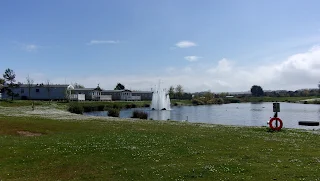












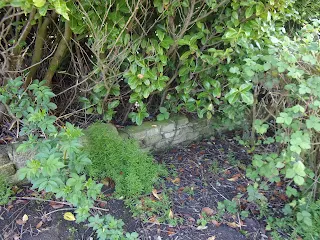


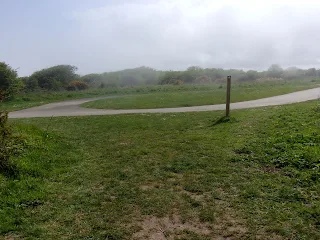









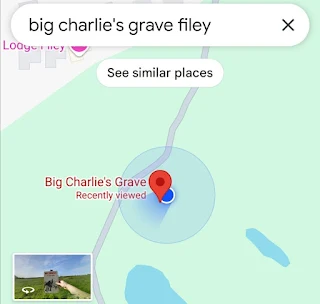


.JPG)









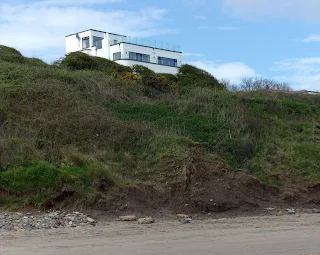







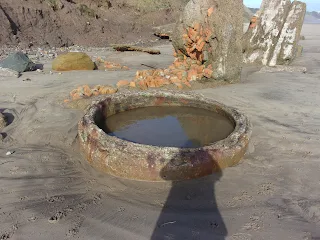












.jpg)







